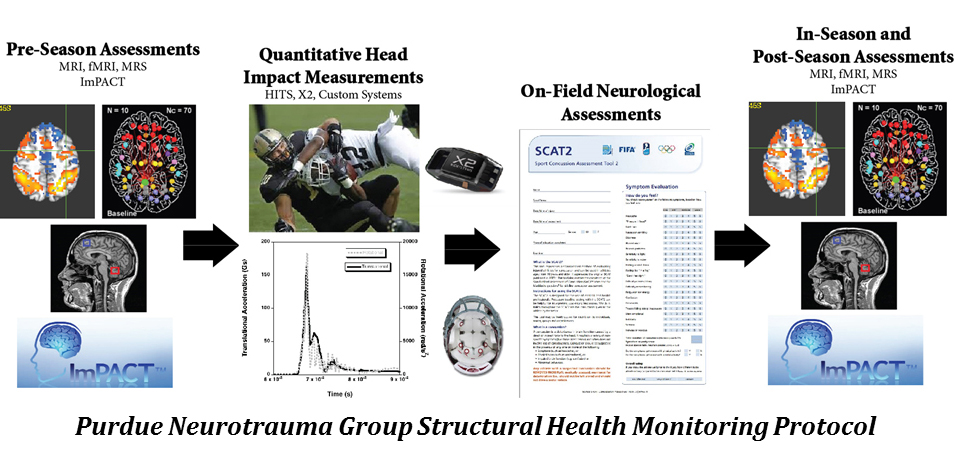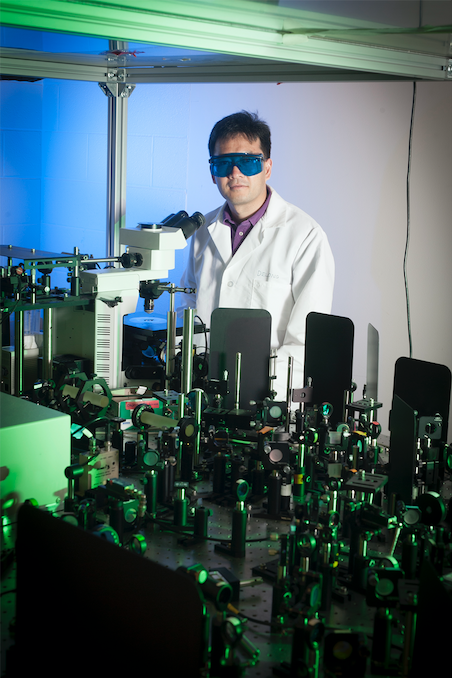Preeminent Teams Tackling Head Trauma, 'Label-free Imaging'
The effort is part of the college's strategic growth plan, which will add as many as 107 faculty over five years. The strategic growth plan is part of Purdue Moves, a range of initiatives designed to broaden Purdue's global impact and enhance educational opportunities for its students.
"The preeminent teams represent a faculty hiring strategy focused on research, and complements our discipline-based faculty hiring," said Leah Jamieson, the John A. Edwardson Dean of Engineering. "These teams have the potential to build dramatically on Purdue's current strengths with strategic hires. Their research will have far-reaching impact."
It is the third annual competition, which brings the total number of teams to 11. The teams competed in a process similar to a pitch entrepreneurs would give to venture capitalists. This year 17 teams, comprising more than 110 faculty members, participated in the competition.
The two Weldon School preeminent teams chosen will focus on:
 Research into "engineering healthier brains through the assessment, treatment and prevention of neurophysiologic injury and disease." The team is led by Thomas M. Talavage, a professor of electrical and computer engineering and biomedical engineering and a founding co-director of the Purdue MRI Facility. Purdue researchers were first to demonstrate that brain physiology can be altered by repeated non-concussive blows to the head, even in the absence of clinical symptoms. The researchers have shown that medical imaging technologies can be used to reliably quantify injury to the brain. The research effort aims to generate new clinical approaches by better understanding the underlying neuropathology of brain injury. Data from various imaging technologies will be used to model both normal and injury states and to identify imaging and biochemical markers for injury. Researchers in the Purdue Neurotrauma Group have pioneered the study of sub-concussive injury and are recognized leaders in brain injury research. The team also is developing new protective technologies such as more effective energy-absorbing materials for football helmets, which have been licensed through the Office of Technology Commercialization. The team was instrumental in forming a new Concussion Neuroimaging Consortium with researchers at the University of Central Florida, Michigan State University, University of Nebraska, Northshore University Hospital, Northwestern University, Ohio State University and Penn State University.
Research into "engineering healthier brains through the assessment, treatment and prevention of neurophysiologic injury and disease." The team is led by Thomas M. Talavage, a professor of electrical and computer engineering and biomedical engineering and a founding co-director of the Purdue MRI Facility. Purdue researchers were first to demonstrate that brain physiology can be altered by repeated non-concussive blows to the head, even in the absence of clinical symptoms. The researchers have shown that medical imaging technologies can be used to reliably quantify injury to the brain. The research effort aims to generate new clinical approaches by better understanding the underlying neuropathology of brain injury. Data from various imaging technologies will be used to model both normal and injury states and to identify imaging and biochemical markers for injury. Researchers in the Purdue Neurotrauma Group have pioneered the study of sub-concussive injury and are recognized leaders in brain injury research. The team also is developing new protective technologies such as more effective energy-absorbing materials for football helmets, which have been licensed through the Office of Technology Commercialization. The team was instrumental in forming a new Concussion Neuroimaging Consortium with researchers at the University of Central Florida, Michigan State University, University of Nebraska, Northshore University Hospital, Northwestern University, Ohio State University and Penn State University.
 Research to develop "label-free" spectroscopic sensing, an emerging platform for biology and medicine. Label-free imaging does not require the use of fluorescent dyes or other preparations to detect structures and features. Because processing kills the tissue and is time-consuming to perform, the label-free technology represents an alternative approach that allows the study of unaltered living tissues and cells, making for more rapid and accurate findings. The multidisciplinary team is led by Ji-Xin Cheng, professor in Purdue's Weldon School of Biomedical Engineering and Department of Chemistry and scientific director of the Label-free Imaging lab at Purdue's Discovery Park. The effort will harness research from several groups in areas as diverse as electrical engineering, chemistry, biology and medicine. Advances in imaging technology could make it possible to quickly reveal precise molecular and chemical information about tissue, providing faster and more accurate diagnoses of conditions including cardiovascular disease and cancer. The technologies will include harnessing ultrasound signals from molecules exposed to a fast-pulsing laser and advanced nonlinear Raman imaging technology capable of near instantaneous measurements of living tissue.
Research to develop "label-free" spectroscopic sensing, an emerging platform for biology and medicine. Label-free imaging does not require the use of fluorescent dyes or other preparations to detect structures and features. Because processing kills the tissue and is time-consuming to perform, the label-free technology represents an alternative approach that allows the study of unaltered living tissues and cells, making for more rapid and accurate findings. The multidisciplinary team is led by Ji-Xin Cheng, professor in Purdue's Weldon School of Biomedical Engineering and Department of Chemistry and scientific director of the Label-free Imaging lab at Purdue's Discovery Park. The effort will harness research from several groups in areas as diverse as electrical engineering, chemistry, biology and medicine. Advances in imaging technology could make it possible to quickly reveal precise molecular and chemical information about tissue, providing faster and more accurate diagnoses of conditions including cardiovascular disease and cancer. The technologies will include harnessing ultrasound signals from molecules exposed to a fast-pulsing laser and advanced nonlinear Raman imaging technology capable of near instantaneous measurements of living tissue.

